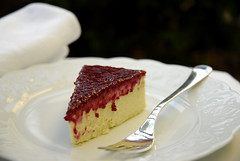 Some people say that Chinese cuisine is one of the 3 most important in the world, after French and Italian. Those cuisines founded the bases for the culinary arts we know today. It’s a shame that a lot of people wont believe it because they only had bad Chinese (usually fast) food. But things are changing, people are getting more interested in this cuisine, there are better Chinese restaurants opening everywhere and various good cookbooks about it.
Some people say that Chinese cuisine is one of the 3 most important in the world, after French and Italian. Those cuisines founded the bases for the culinary arts we know today. It’s a shame that a lot of people wont believe it because they only had bad Chinese (usually fast) food. But things are changing, people are getting more interested in this cuisine, there are better Chinese restaurants opening everywhere and various good cookbooks about it. Last year I learned a little more about it by taking an Asian cuisine course at CIA. On the first day of class we found very weird that our teacher was a big German guy! Soon we knew we couldn’t have a better teacher. He lived many years in China, married a Chinese girl, speaks Chinese, loves the food and knows everything about it. We learned that vegetables, noodles (made of wheat and rice) and pork are very common ingredients. Soy sauce, scallions, garlic, ginger and chilies are the basics seasonings and appear in many recipes. They also use several dried products such as: mushrooms, shrimp, scallops, oysters, bird’s nest and shark’s fin. The Chinese style of cooking is based on the philosophy of balancing yin and yang... harmony arises from the proper blend of opposites. Beautiful! Most Chinese dishes are based on five traditional flavors: sweet, salty, bitter, sour and hot. And ingredients are paired to achieve rounder, more complex flavors. The meals are nutritiously well balanced: they have protein, carbohydrates and vegetables. They use their unique technique of stir-frying and the sensational Wok pan. There are four major Chinese cuisines: Beijing (Peking) in the Northern region, Shanghai (Eastern), Cantonese (Southern) and Szechwan (Western). In the Northern region (Beijing) the staple is wheat flour. They use wine stock and their cooking includes pungent sweet and sour dishes as well as subtler, delicately seasoned foods. In the eastern region (Shanghai) wheat flour is replaced by rice as a staple. They use more soy sauce and sugar. Vegetables are abundant and celebrated dishes include bird’s nest soup and a wide range of seafood. Southern (Cantonese) cooking is subtle and the least greasy of all. They do a lot of stir-frying and the familiar dishes of this region are dim sum. Western (Szechwan) is known for its fragrant peppercorns called fagara (or Szechwan pepper) and the characteristics of the food are its vigor and zest.
The recipe I'm writing down is one of the first we did in class. It's good and so simple... you should try! The only problem is that I don’t remember from which region it comes from... Would you guess?
Egg Fried Rice (for 2)
Ingredients:
2 Eggs
½ tsp salt
1 tsp soy sauce
2 tbsp peanut or vegetable oil
2 oz lean bacon, finely chopped
2 scallions, finely chopped
1 oz carrots, finally chopped
25oz long-grain rice, cooked and cooled
In a small bowl, whisk the eggs, salt and soy sauce. Heat a wok over high heat. Add the oil, scallions and carrots. Stir-fry for 30 seconds. Add the egg mixture, cook for 30 seconds, mixing with a spatula and breaking the egg up, like when doing omelet. Add the bacon and the rice, mixing aggressively to break up the rice into the eggs. Stir-fry for 3 minutes, turn the rice into the plates and serve.





No comments:
Post a Comment